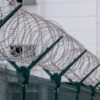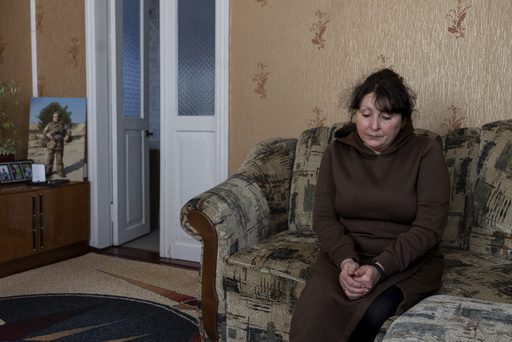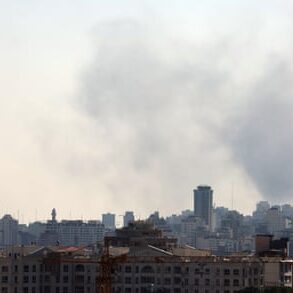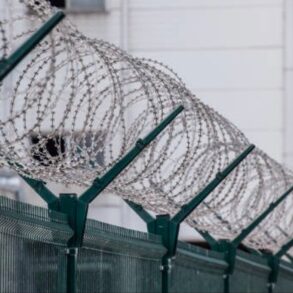KYIV, Ukraine (AP) — “Everything will be all right.”
Ukrainian soldier Serhii Hryhoriev said this so often during brief phone calls from the front that his wife and two daughters took it to heart. His younger daughter, Oksana, tattooed the phrase on her wrist as a talisman.
Even after Hryhoriev was captured by the Russian army in 2022, his anxious family clung to the belief that he would ultimately be OK. After all, Russia is bound by international law to protect prisoners of war.
When Hryhoriev finally came home, though, it was in a body bag.
A Russian death certificate said the 59-year-old died of a stroke. But a Ukrainian autopsy and a former POW who was detained with him tell a different story about how he died – one of violence and medical neglect at the hands of his captors.
Hryhoriev is one of more than 200 Ukrainian POWs who have died while imprisoned since Russia’s full-scale invasion three years ago. Abuse inside Russian prisons was likely a contributing factor in many of these deaths, according to officials from human rights groups, the U.N., the Ukrainian government and a Ukrainian medical examiner who has performed dozens of POW autopsies.
The officials say the prison death toll adds to evidence that Russia is systematically brutalizing captured soldiers. They say forensic discrepancies like Hryhoriev’s, and the repatriation of bodies that are mutilated and decomposed, point to an effort to cover up alleged torture, starvation and poor health care at dozens of prisons and detention centers across Russia and occupied Ukraine.
Russian authorities did not respond to requests for comment. They have previously accused Ukraine of mistreating Russian POWs — allegations the U.N. has partially backed up, though it says Ukraine’s violations are far less common and severe than what Russia is accused of.
‘Alive and well’
Hryhoriev joined the Ukrainian army in 2019 after he lost his job as an office worker at a high school. When the war began three years later, he was stationed with other soldiers in Mariupol, an industrial port city that was the site of a fierce battle — and far from his home in the central Poltava region.
On April 10, 2022, Hryhoriev called his family to reassure them that “everything will be all right.” That was the last time they ever spoke to him.
Two days later, a relative of a soldier in Hryhoriev’s unit called to say the men had been captured. After Mariupol fell to Russia, more than 2,000 soldiers defending the city became Russian prisoners.
Soon his family got a call from the International Committee of the Red Cross, which confirmed he was alive and officially registered as a POW, guaranteeing his protection under the Geneva Conventions. “We were told: ‘that means everything is fine … Russia has to return him,’” Hryhoriev’s wife, Halyna, recalled.
In August 2022, she received a letter from him, that addressed her by a nickname. “My dear Halochka,” he wrote. “I am alive and well. Everything will be all right.”
Desperate for more information, his daughter Oksana, 31, scoured Russian social media accounts, where videos of Ukrainian POWs regularly appeared. Eventually, she saw him in one — looking gaunt and missing teeth. His gray hair was cropped very short, framing gentle features now partially covered by a beard.
In the video, likely shot under duress, Hryhoriev said to the camera: “I’m alive and well.”
“But if you looked at him, you could see that wasn’t true,” Oksana said.
The truth was dismal, said Oleksii Honcharov, a 48-year-old Ukrainian POW who was detained with him.
Honcharov lived in the same prison barracks as Hryhoriev starting in the fall of 2022. Over a period of months, he witnessed Hryhoriev absorb the same severe punishment as every other POW at the Kamensk-Shakhtinsky Correctional Colony in southwest Russia.
“Everyone got hit — no exceptions,” said Honcharov, who was repatriated to Ukraine in February as part of a prisoner swap. “Some more, some less, but we all took it.”
Honcharov endured months of chest pain while in captivity. Even then, the beatings never stopped, he said, and sometimes they began after his pleas for medical care, which were ignored.
“Toward the end, I could barely walk,” said Honcharov, who was diagnosed with tuberculosis once back in Ukraine – an increasingly common ailment among returning POWs.
A 2024 U.N. report found that 95% of released Ukrainian POWs had endured “systematic” torture. Prisoners described beatings, electric shocks, suffocation, sexual violence, prolonged stress positions, mock executions, and sleep deprivation.
“This conduct could not be more unlawful,” said Danielle Bell, the U.N.’s top human rights monitor in Ukraine.
The report also said some Russian POWs were mistreated by Ukrainian forces during their initial capture — including beatings, threats and electric shocks. But the abuse stopped once Russian POWs were moved to official Ukrainian detention centers, the report said.
Hryhoriev was physically strong and often outlasted younger prisoners during forced exercises, Honcharov recalled. But over time, he began showing signs of physical decline: dizziness, fatigue and, eventually, an inability to walk without help.
Yet despite his worsening condition, prison officials provided only minimal health care, Honcharov said.
Piecing together how POWs died
In a bright, sterile room with the sour-sweet smell of human decomposition, Inna Padei performs autopsies on Ukrainian soldiers repatriated by Russia, as well as civilians exhumed from mass graves. Hundreds of bodies zipped up in black plastic bags have been delivered in refrigerated trucks to the morgue where she works in Kyiv, the capital of Ukraine.
Those who died in battle are still wearing military fatigues and often have obvious external wounds. The bodies of former POWs are dressed in prison uniforms and are often mutilated and decomposed.
It is the job of Padei and other forensic experts to piece together how soldiers like Hryhoriev died. These reports are often the only reliable information the soldiers’ families get — and they will be used by Ukraine, along with testimony from former POWs, to bring war crimes charges against Russia at the International Criminal Court.
The body of a former POW recently examined by Padei had an almond-sized fracture on the right side of its skull. That suggested the soldier was struck by a blunt object – a blow potentially strong enough to have killed him instantly, or shortly after, she said.
“These injuries may not always be the direct cause of death,” Padei said, “but they clearly indicate the use of force and torture against the servicemen.”
Earlier this year, Amnesty International documented widespread torture of Ukrainian POWs in Russia. Its report was especially critical of Russia’s secrecy regarding the whereabouts and condition of POWs, saying it refused to grant rights groups or health workers access to its prisons, leaving families in the dark for months or years about their loved ones.
Of the more than 5,000 POWs Russia has repatriated to Ukraine, at least 206 died in captivity, including more than 50 when an explosion ripped through a Russian-controlled prison barracks, according to the Ukrainian government. An additional 245 Ukrainian POWs were killed by Russian soldiers on the battlefield, according to Ukrainian prosecutors.
The toll of dead POWs is expected to rise as more bodies are returned and identified, but forensic experts face significant challenges in determining causes of death.
In some cases, internal organs are missing. Other times, it appears as if bruises or injuries have been hidden or removed.
Ukrainian officials believe the mutilation of bodies is an effort by Russia to conceal the true causes of death. Extreme decomposition is another obstacle, officials say.
“They hold the bodies until they reach a state where nothing can be determined,” said Petro Yatsenko, a spokesperson for the Ukrainian government agency in charge of POW affairs.
Ukrainian President Volodymyr Zelenskyy has said the prompt exchange of POWs must be part of any ceasefire agreement, along with the return of thousands of Ukrainian civilians, including children forcibly deported to Russia. A major prisoner exchange between Russia and Ukraine took place over the weekend.
The Associated Press interviewed relatives of 21 Ukrainian POWs who died in captivity. Autopsies performed in Ukraine found that five of these POWs died of heart failure, including soldiers who were 22, 39 and 43. Four others died from tuberculosis or pneumonia, and three others perished, respectively, from an infection, asphyxia and a blunt force head wound.
Padei said cases like these — and others she has seen — are red flags, suggesting that physical abuse and untreated injuries and illness likely contributed to many soldiers’ deaths.
“Under normal or humane conditions, these would not have been fatal,” Padei said.
In one autopsy report, coroners said an individual had been electrocuted and beaten just days before dying of heart failure and extreme emaciation. Other autopsies noted that bodies showed signs of gangrene or untreated infections.
“Everything the returned prisoners describe … we see the same on the bodies,” Padei said.
‘Angel in the sky’
Months into Hryhoriev’s detention at the Kamensk-Shakhtinsky prison – and after his daughter saw him in the Russian army’s social media video — his health deteriorated significantly, according to Honcharov.
But instead of being sent to a hospital, Hryhoriev was moved to a tiny cell that was isolated from other prisoners. Another Ukrainian captive, a paramedic, was assigned to stay with him.
“It was damp, cold, with no lighting at all,” recalled Honcharov.
He died in that cell about a month later, Honcharov said. It was May 20, 2023, according to his Russian death certificate.
The Hryhoriev family didn’t learn he had died until more than six months later, when a former POW reached out. Then, in March 2024, police in central Ukraine called: A body had arrived with a Russian death certificate bearing Hryhoriev’s name. A DNA test confirmed it was him.
An autopsy performed in Ukraine disputed Russia’s claim that Hryhoriev died of a stroke. It said he bled to death after blunt trauma to his abdomen that also damaged his spleen.
Hryhoriev’s body was handed over to the family last June, and soon after he was buried in his hometown of Pyriatyn.
To honor him, Hryhoriev’s wife and older daughter, Yana, followed Oksana’s lead and tattooed their wrists with the optimistic expression he had drilled into them.
“Now we have an angel in the sky watching over us,” Halyna said. “We believe everything will be all right.”
___
Associated Press reporters Yehor Konovalov, Alex Babenko and Anton Shtuka in Kyiv, and Dasha Litvinova in Tallinn, Estonia, contributed to this report.
Copyright 2025 The Associated Press. All rights reserved. This material may not be published, broadcast, rewritten or redistributed without permission.
This post was originally published on this site be sure to check out more of their content.









